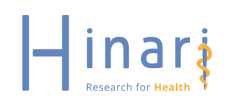Conceptos epidemiológicos, manejo diagnóstico y farmacológico de la insuficiencia cardiaca congestiva crónica
Resumen
La insuficiencia cardiaca (IC) es un síndrome clínico complejo que resulta de cualquier deterioro estructural o funcional del llenado ventricular o gasto cardiaco. Las manifestaciones clínicas típicas de la insuficiencia cardiaca son disnea y fatiga, que pueden limitar la tolerancia al ejercicio, y retención de líquidos, lo que pueden conducir a la congestión pulmonar y esplácnica, y edema periférico. La prevalencia de la IC se sitúa aproximadamente en el 1-2% de la población adulta en países desarrollados, y aumenta a más del 10% entre personas de 70 o más años de edad. El riesgo de IC a los 55 años es del 33% para los varones y el 28% para las mujeres. Es categórico el hecho de la existencia de una tendencia demográfica hacia el aumento de la longevidad de la población en general, lo cual implica a su vez un aumento en la incidencia de la insuficiencia cardiaca. Por lo tanto, las investigaciones científicas se deben dirigir al estudio del manejo diagnóstico y terapéutico de esta población con edad avanzada. Normalmente, la miocardiopatía es la causa de la disfunción ventricular sistólica o diastólica. No obstante, las anomalías de válvulas, pericardio, endocardio, ritmo cardiaco y conducción también pueden causar IC, en algunas ocasiones se puede deber a la combinación de más de una de ellas. Los objetivos del tratamiento para los pacientes con IC son mejorar el estado clínico, la capacidad funcional y la calidad de vida, prevenir las hospitalizaciones y reducir la mortalidad. Los estudios experimentales y clínicos deben enfocarse a seguir aportando datos sobre la fisiopatología, la influencia de la edad, los criterios diagnósticos, la caracterización de subgrupos especiales, y la identificación de nuevos agentes farmacológicos para mejorar la estrategia terapéutica preventiva y curativa en pacientes con insuficiencia cardiaca congestiva crónica.
Citas
2. Yancy CW, Jessup M, Bozkurt B, Butler J, Casey DE Jr, Drazner MH, et al. 2013 ACCF/AHA guideline for the management of heart failure: executive summary: a report of the American College of Cardiology Foundation/American Heart Association Task Force on practice guidelines. Circulation. 2013;128(16):1810-1852.
3. Martindale JL, Wakai A, Collins SP, Levy PD, Diercks D, Hiestand BC, Fermann GJ, de Souza I, Sinert R. Diagnosing acute heart failure in the emergency department: A systematic review and meta-analysis. Acad Emerg Med. 2016; 23(3):223–42.
4. Ponikowski P, Jankowska E. Patogenia y presentación clínica de la insuficiencia cardiaca aguda. Rev Esp Cardiol. 2015;68(4):331-7.
5. AlHabib KF, Elasfar AA, Alfaleh H, Kashour T, Hersi A, AlBackr H, et al. Clinical features, management, and short- and long-term outcomes of patients with acute decompensated heart failure: phase I results of the HEARTS database. Eur J Heart Fail. 2014;16(4):461-9.
6. Panduranga P, Sulaiman K, Al-Zakwani I, Alazzawi AA, Abraham A, Singh PP, et al. Demographics, clinical characteristics, management, and outcomes of acute heart failure patients: Observations from the oman acute heart failure registry. Oman Med J. 2016;31(3):188-95.
7. Bleumink GS, Knetsch AM, Sturkenboom MC, Strausa SM, Hofman A, Deckers JW, Wittemann JC, Strickera BH. Quantifying the heart failure epidemic: prevalence, incidence rate, lifetime risk and prognosis of heart failure The Rotterdam Study. Eur Heart J. 2004; 25(18):1614–9.
8. Fonarow GC, Abraham WT, Albert NM, Gattis Stough W, Gheorghiade M, Greenberg BH, et al. Influence of a performance-improvement initiative on quality of care for patients hospitalized with heart failure results of the Organized Program to Initiate Lifesaving Treatment in Hospitalized Patients With Heart Failure (OPTIMIZE-HF). Arch Intern Med. 2007;167(14):1493-502.
9. Parenica J, Spinar J, Vitovec J, Widimsky P, Linhart A, Fedorco M, et al. Long-term survival following acute heart failure: The Acute Heart Failure Database Main registry (AHEAD Main). Eur J Intern Med. 2013; 24(2):151-60.
10. Purek L, Laule-Kilian K, Christ A, Klima T, Pfisterer ME, Perruchoud AP, Mueller C. Coronary artery disease and outcome in acute congestive heart failure. Heart. 2006; 92(5):598–602.
11. Nieminen MS, Brutsaert D, Dickstein K, Drexler H, Follath F, Harjola VP, et al. EuroHeart Failure Survey II (EHFS II): a survey on hospitalized acute heart failure patients: description of population. Eur Heart J. 2006; 27(22):2725-2736.
12. Steg PG, Dabbous OH, Feldman LJ, Cohen-Solal A, Aumont MC, Lopez-Sendon J, et al. Determinants and prognostic impact of heart failure complicating acute coronary syndromes: observations from the Global Registry of Acute Coronary Events (GRACE). Circulation. 2004; 109(4):494-9.
13. AlFaleh H, Elasfar AA, Ullah A, AlHabib KF, Hersi A, Mimish L, et al. Acute heart failure with and without acute coronary syndrome: clinical correlates and prognostic impact (From the HEARTS registry). BMC Cardiovasc Disord. 2016; 16:98.
14. Tarvasmäki T, Harjola VP, Nieminen MS, Siirilä-Waris K, Tolonen J, Tolppanen H, et al. Acute heart failure with and without concomitant acute coronary syndromes: patient characteristics, management, and survival. J Card Fail. 2014;20(10):723-30.
15. Djousse L, Driver JA, Gaziano JM. Relation between modifiable lifestyle factors and lifetime risk of heart failure. JAMA 2009; 302(4):394–400.
16. Maggioni AP, Dahlström U, Filippatos G, Chioncel O, Crespo Leiro M, Drozdz J, et al. EURObservational Research Programme: regional differences and 1-year follow-up results of the Heart Failure Pilot Survey (ESC-HF Pilot). Eur J Heart Fail. 2013; 15(7):808-17.
17. Crespo-Leiro MG, Anker SD, Maggioni AP, Coats AJ, Filippatos G, Ruschitzka F, et al. European Society of Cardiology Heart Failure Long-Term Registry (ESC-HF-LT): 1-year follow-up outcomes and differences across regions. Eur J Heart Fail. 2016;18(6):613-25.
18. Ammar KA, Jacobsen SJ, Mahoney DW, Kors JA, Redfield MM, Burnett JC Jr, Rodeheffer RJ. Prevalence and prognostic significance of heart failure stages: application of the American College of Cardiology/American Heart Association heart failure staging criteria in the community. Circulation. 2007;115(12):1563-70.
19. Felker GM, Mentz RJ, Teerlink JR, Voors AA, Pang PS, Ponikowski P, et al. Serial high sensitivity cardiac troponin T measurement in acute heart failure: insights from the RELAX-AHF study. Eur J Heart Fail. 2015; 17(12):1262-70.
20. American College of Emergency Physicians; Society for Cardiovascular Angiography and Interventions, O'Gara PT, Kushner FG, Ascheim DD, Casey DE Jr, et al. 2013 ACCF/AHA guideline for the management of ST-elevation myocardial infarction: executive summary: a report of the American College of Cardiology Foundation/American Heart Association Task Force on Practice Guidelines. J Am Coll Cardiol. 2013; 61(4):485-510.
21. Amsterdam EA, Wenger NK, Brindis RG, Casey DE Jr, Ganiats TG, Holmes DR Jr, et al. 2014 AHA/ACC Guideline for the Management of Patients with Non-ST-Elevation Acute Coronary Syndromes: a report of the American College of Cardiology/American Heart Association Task Force on Practice Guidelines. J Am Coll Cardiol. 2014;64(24):e139-e228.
22. Ibanez B, James S, Agewall S, Antunes MJ, Bucciarelli-Ducci C, Bueno H, et al. 2017 ESC Guidelines for the management of acute myocardial infarction in patients presenting with ST-segment elevation: The Task Force for the management of acute myocardial infarction in patients presenting with ST-segment elevation of the European Society of Cardiology (ESC). Eur Heart J. 2018; 39(2):119-77.
23. Roffi M, Patrono C, Collet JP, Mueller C, Valgimigli M, Andreotti F, el at. Guía ESC 2015 sobre el tratamiento de los síndromes coronarios agudos en pacientes sin elevación persistente del segmento ST. Rev Esp Cardiol. 2015;68(12):1125. e1-e64.
24. Konstantinides SV, Torbicki A, Agnelli G, Danchin N, Fitzmaurice D, Galiè N, et al. 2014 ESC guidelines on the diagnosis and management of acute pulmonary embolism: The task force for the diagnosis and management of acute pulmonary embolism of the European Society of Cardiology (ESC). Eur Heart J. 2014;35(43):3033-69.
25. Mebazaa A, Yilmaz MB, Levy P, Ponikowski P, Peacock WF, Laribi S, et al. Recommendations on pre-hospital & early hospital management of acute heart failure: a consensus paper from the Heart Failure Association of the European Society of Cardiology, the European Society of Emergency Medicine and the Society of Academic Emergency Medicine. Eur J Heart Fail. 2015;17(6):544-58.
26. Prins KW, Neill JM, Tyler JO, Eckman PM, Duval S. Effects of beta-blocker withdrawal in acute decompensated heart failure: A systematic review and meta-analysis. JACC Heart Fail. 2015; 3(8):647-53. doi: 10.1016/j.jchf.2015.03.008.
27. Faris RF, Flather M, Purcell H, Poole-Wilson PA, Coats AJ. Diuretics for heart failure. Cochrane Database Syst Rev. 2012;15 (2):CD003838.
28. King JB, Bress AP, Reese AD, Munger MA. Neprilysin inhibition in heart failure with reduced ejection fraction: a clinical review. Pharmacotherapy. 2015; 35(9):823–37.
29. McMurray JJ, Packer M, Desai AS, Gong J, Lefkowitz MP, Rizkala AR, et al. Dual angiotensin receptor and neprilysin inhibition as an alternative to angiotensin-converting enzyme inhibition in patients with chronic systolic heart failure: rationale for and design of the Prospective comparison of ARNI with ACEI to Determine Impact on Global Mortality and morbidity in Heart Failure trial (PARADIGM-HF). Eur J Heart Fail. 2013;15(9):1062-73.
30. Hartmann C, Bosch NL, de Aragão Miguita L, Tierie E, Zytinski L, Baena CP. The effect of ivabradine therapy on heart failure patients with reduced ejection fraction: a systematic review and meta-analysis. Int J Clin Pharm. 2018; 40(6): 1443-53.
31. Li S, Zhang X, Dong M, Gong S, Shang Z, Jia X, Chen W, Yang J, Li J. Effects of spironolactone in heart failure with preserved ejection fraction: A meta-analysis of randomized controlled trials. Medicine (Baltimore). 2018;97(35): e11942.
32. Alkhawam H, Abo-Salem E, Zaiem F, Ampadu J, Rahman A, Sulaiman S, Zaitoun A, Helmy T, Vittorio TJ. Effect of digitalis level on readmission and mortality rate among heart failure reduced ejection fraction patients. Heart Lung. 2019; 48(1): 22-27.
33. Wehrens XHT. Unraveling the mechanisms by which calpain inhibition prevents heart failure development. JACC Basic Transl Sci. 2018; 3(4):518-20.
34. Sulaiman KJ, Panduranga P, Al-Zakwani I, Alsheikh-Ali A, AlHabib KF, Al-Suwaidi J, et al. Rationale, design, methodology and hospital characteristics of the first gulf acute heart failure registry (Gulf CARE). Heart Views. 2014;15(1):6-12.
35. Mozzini C, Cominacini L, Casadei A, Schiavone C, Soresi M. Ultrasonography in heart failure: A story that matters. Curr Probl Cardiol. 2018. Pii: S0146-2806(18)30064-1.
36. Oikonomou E, Chrysohoou C, Tousoulis D. Heart failure a cluster of comorbidities or a unique entity?. Int J Cardiol. 2018. pii: S0167-5273(18)34193-7.
37. Spinar J, Parenica J, Vitovec J, Widimsky P, Linhart A, Fedorco M, et al. Baseline characteristics and hospital mortality in the Acute Heart Failure Database (AHEAD) Main registry. Crit Care. 2011;15(6):R291.
38. Samuel TJ, Beaudry R, Sarma S, Zaha V, Haykowsky MJ, Nelson MD. Diastolic stress testing along the heart failure continuum. Curr Heart Fail Rep. 2018; 15(6): 332-9. doi: 10.1007/s11897-018-0409-5.
39. Follath F, Yilmaz MB, Delgado JF, Parissis JT, Porcher R, Gayat E, et al. Clinical presentation, management and outcomes in the Acute Heart Failure Global Survey of Standard Treatment (ALARM-HF). Intensive Care Med. 2011;37(4):619-26.
40. Luo N, O'Connor CM, Cooper LB, Sun JL, Coles A, Reed SD, et al. Relationship between changing patient-reported outcomes and subsequent clinical events in patients with chronic heart failure: insights from HF-ACTION. Eur J Heart Fail. 2018.doi: 10.1002/ejhf. 1299.
41. Greenberg G, Cohen E, Garty M, Iakobishvili Z, Sandach A, Behar S, et al. Outcomes of acute heart failure associated with acute coronary syndrome versus other causes. Acute Card Care. 2011;13(2):87-92.
42. Gernhofer YK, Braun OO, Brambatti M, Bui QM, Jorge SE, Greenberg BH, Adler E, Pretorius V. Which advanced heart failure therapy strategy is optimal for patients over 60 years old? J Cardiovasc Surg (Torino). 2018. Doi: 10.23736/S0021-9509. 18. 10593-3.
43. Shah RV, Holmes D, Anderson M, Wang TY, Kontos MC, Wiviott SD, Scirica BM. Risk of heart failure complication during hospitalization for acute myocardial infarction in a contemporary population: insights from the National Cardiovascular Data ACTION Registry. Circ Heart Fail. 2012;5(6):693-702.
44. Schroten NF, Damman K, Hemmelder MH, Voors AA, Navis G, Gaillard CA, van Veldhuisen DJ, Van Gilst WH, Hillege HL. Effect of additive renin inhibition with aliskiren on renal blood flow in patients with Chronic Heart Failure and Renal Dysfunction (Additive Renin Inhibition with Aliskiren on renal blood flow and Neurohormonal Activation in patients with Chronic Heart Failure and Renal Dysfunction). Am Heart J. 2015;169(5):693-701.
45. Warraich HJ, Xu H, DeVore AD, Matsouaka R, Heidenreich PA, Bhatt DL, Hernandez AF, Yancy CW, Fonarow GC, Allen LA. Trends in hospice discharge and relative outcomes among medicare patients in the get with the guidelines-heart failure registry. JAMA Cardiol. 2018; 3(10): 917-926.
46. Flaherty JD, Bax JJ, De Luca L, Rossi JS, Davidson CJ, Filippatos G, et al. Acute heart failure syndromes in patients with coronary artery disease early assessment and treatment. J Am Coll Cardiol. 2009; 53(3):254-63.
47. Sulo G, Igland J, Nygård O, Vollset SE, Ebbing M, Poulter N, Egeland GM, Cerqueira C, Jørgensen T, Tell GS. Prognostic impact of in-hospital and postdischarge heart failure in patients with acute myocardial infarction: A Nationwide Analysis Using Data From the Cardiovascular Disease in Norway (CVDNOR) Project. J Am Heart Assoc. 2017;6(3). pii: e005277.
48. Tromp J, Westenbrink BD, Ouwerkerk W, van Veldhuisen DJ, Samani NJ, Ponikowski P, et al. Identifying pathophysiological mechanisms in heart failure with reduced versus preserved ejection fraction. J Am Coll Cardiol. 2018;72(10):1081-90.
49. Montero-Perez-Barquero M, Flather M, Roughton M, Coats A, Böhm M, Van Veldhuisen DJ, Babalis D, Solal AC, Manzano L. Influence of systolic blood pressure on clinical outcomes in elderly heart failure patients treated with nebivolol: data from the SENIORS trial. Eur J Heart Fail. 2014;16(9):1009-15.
50. Contini M, Apostolo A, Cattadori G, Paolillo S, Iorio A, Bertella E, et al. Multiparametric comparison of CARvedilol, vs. NEbivolol, vs. BIsoprolol in moderate heart failure: the CARNEBI trial. Int J Cardiol. 2013;168(3):2134-2140.
51. Karabacak M, Doğan A, Tayyar Ş, Özaydın M, Erdoğan D. Carvedilol and nebivolol improve left ventricular systolic functions in patients with non-ischemic heart failure. Anatol J Cardiol. 2015;15(4):271-6.
52. Zinman B, Wanner C, Lachin JM, Fitchett D, Bluhmki E, Hantel S, et al. Empagliflozin, cardiovascular outcomes, and mortality in type 2 diabetes. N Engl J Med. 2015;373(22):2117-28.
53. Zinman B, Inzucchi SE, Lachin JM, Wanner C, Ferrari R, Fitchett D, et al. Rationale, design, and baseline characteristics of a randomized, placebo-controlled cardiovascular outcome trial of empagliflozin (EMPA-REG OUTCOME™). Cardiovasc Diabetol. 2014 Jun 19; 13:102.
54. Gladden JD, Linke WA, Redfield MM. Heart failure with preserved ejection fraction. Pflugers Arch. 2014; 466(6):1037–53.
55. Redfield MM, Jacobsen SJ, Burnett JC Jr, Mahoney DW, Bailey KR, Rodeheffer RJ. Burden of systolic and diastolic ventricular dysfunction in the community: appreciating the scope of the heart failure epidemic. JAMA 2003; 289(2):194–202.

















